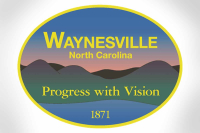Déjà vu: N.C. 107 planners struggle to find solutions to road dilemma

After taking input from the more than 100 people who attended a Jan. 14 public forum and carefully combing their suggestions for the upcoming N.C. 107 makeover in Sylva, the Asheville Design Center generated a respectably long list of design alternatives to investigate.
But when the N.C. Department of Transportation returned its written responses to those alternatives, the answers were mostly variations of “we already looked into that, and it won’t work.”
“I feel like DOT is saying, ‘if you’ve got better ideas, please put them on the table. We’re open to them,’” said Chris Joyell, director of the Asheville Design Center. “But what we’re finding is they’ve been looking at this problem for eight years, and I don’t think there’s a lot of surprises left for them.”
Joyell said that he was impressed to see that the DOT had explored even unconventional solutions, like putting bike lanes through the median rather than on the sides and building a one-way road parallel to N.C. 107 rather than expanding the blueprint of the existing road.
“It’s a little frustrating on our end because we love to find the silver bullet and bring new ideas to the table, but what we’re finding is a lot of these ideas have been kicked around already,” said Joyell.
Still, he believes that the ADC’s involvement — which is provided on a pro-bono basis using volunteer professionals in fields such as planning and engineering — will ultimately serve to reduce impacts.
Related Items
For one, the organization is working to bring utilities like Duke Energy the Tuckseigee Water and Sewer Authority to the table earlier in the process than they otherwise would be. The hope is that this will allow their needs to be incorporated into the plans earlier than would otherwise occur, reducing the extent of utility easements ultimately required.
Joyell also hopes to accomplish enhanced pedestrian planning and to help fine-tune plans to reduce impacts on individual properties. The ADC could also help brainstorm some solutions that fall outside of DOT’s purview. Much of the right-of-way impact will come from the bike lanes and widened sidewalks planned for each side of the road — Joyell said the ideal solution would be to address those needs through a separated, greenway-like path that could run behind the businesses and cause substantially less disruption to current uses. However, such a path would fall outside the boundary of the N.C. 107 project, putting the town on the hook for what would undoubtedly be an expensive and complex project.
“It could be submitted to Strategic Transportation Prioritization as a standalone bike/ped project,” the DOT wrote in response to an ADC question on the matter. “If it scored well and got funded the town would have to pay a percentage of the entire cost, including right-of-way. It would be expensive, impactful and may not even be feasible.”
Preliminary plans for the N.C. 107 redesign were released last spring and drew widespread criticism when 54 businesses, one nonprofit and five residences were listed for relocation due to impacts from the project. Under the plan, the road — which currently consists of two lanes in each direction and one middle turn lane — would remain a four-lane road with restricted turns and entrances aimed at improving traffic flow and reducing accidents.
A February 2018 estimate put right-of-way work for the project at $47.6 million, with initial estimates in 2017 predicting $18.6 million for construction. Right-of-way acquisition is set to begin in January 2020. Because right-of-way is expected to take so long, the start of the two-year construction period has been pushed back from December 2021 to December 2022, Sylva Town Manager Paige Dowling told the board Jan. 24.
Winter weather has caused multiple delays to the ADC’s planned schedule to deliver its design recommendations, but the group hopes to meet with utility providers in February and to hold a work session with Sylva and DOT officials later this month. From there it will develop draft recommendations, hold a public forum to gather input on those recommendations, and deliver a final document around mid-March.
Responses from the DOT
Throughout the past year, members of the public have offered up various ideas for reducing negative impacts from the planned N.C. 107 project in Sylva. The Asheville Design Center ran many of these ideas by the N.C. Department of Transportation last month and received written responses to each.
Would narrowing the lanes from 12 to 11 feet reduce right-of-way while still allowing the road to be functional?
The DOT considered narrowing the travel lanes following a public meeting in February 2017, as doing so would reduce the roadway width by 2 feet on either side, in turn reducing impacts to adjacent properties. However, those reduced impacts could be offset by easements needed to relocate utilities. Also considering that wider travel lanes will enhance safety and mobility for drivers, DOT concluded that the lanes should remain 12 feet wide.
If sidewalks and bike lanes were combined into a single 10-foot path on either side, would right-of-way decrease?
Combining the sidewalk and bike lane would actually increase the right-of-way by 2 feet. A standard 5-foot sidewalk would require a 10-foot flat shoulder width behind the curb, but with a 10-foot path a 15-foot shoulder is required. Also, Complete Streets requires a 14-foot outside lane, which would increase right-of-way. Vehicles waiting to exit driveways often block the sidewalk area, and drivers are less likely to see bikes riding on the sidewalk, creating a safety issue. The local government cost-share would be larger for a multi-use path too.
Would the DOT consider placing a center bike lane in the median?
A center bike lane would result in a wider footprint, because the 17.5-foot median includes many 12-foot turn lanes, leaving only 5.5 feet for the island and striping. A center bike lane would require 5 feet for each travel direction plus 5 feet of buffer on each side for a total of 20 feet, requiring the curbs to extend 5 feet wider on each side. A center lane would also create safety concerns as cyclists cross traffic to reach their destination on either side.
Is a one-way road parallel to N.C. 107 a possibility?
The concept was analyzed while developing Jackson County’s comprehensive plan in 2017, and terrain would prevent construction of a road that closely parallels N.C. 107. To achieve an acceptable grade without moving vast amounts of earth, the road would have to curve around the ridges, resulting in longer travel times and less acceptable service than the existing road. Constructing the road would cause substantial right-of-way impacts, especially considering the need for multiple connections to N.C. 107.
Is a roundabout possible at the intersection of Main Street and U.S. 23?
A roundabout was considered in the feasibility study, but even a dual-lane roundabout could not handle the traffic unless a flyover bridge was added. However, a roundabout with a flyover bridge would cause substantially more property impacts than the current design.
The above answers are paraphrases of a sampling of the many questions DOT answered. To view the entire document, click here. To see the community input ADC gathered on the road plans, visit https://drive.google.com/drive/folders/1RvNsQdbj7HYaOyhgX0kdVlqlB-vyPJ04.









